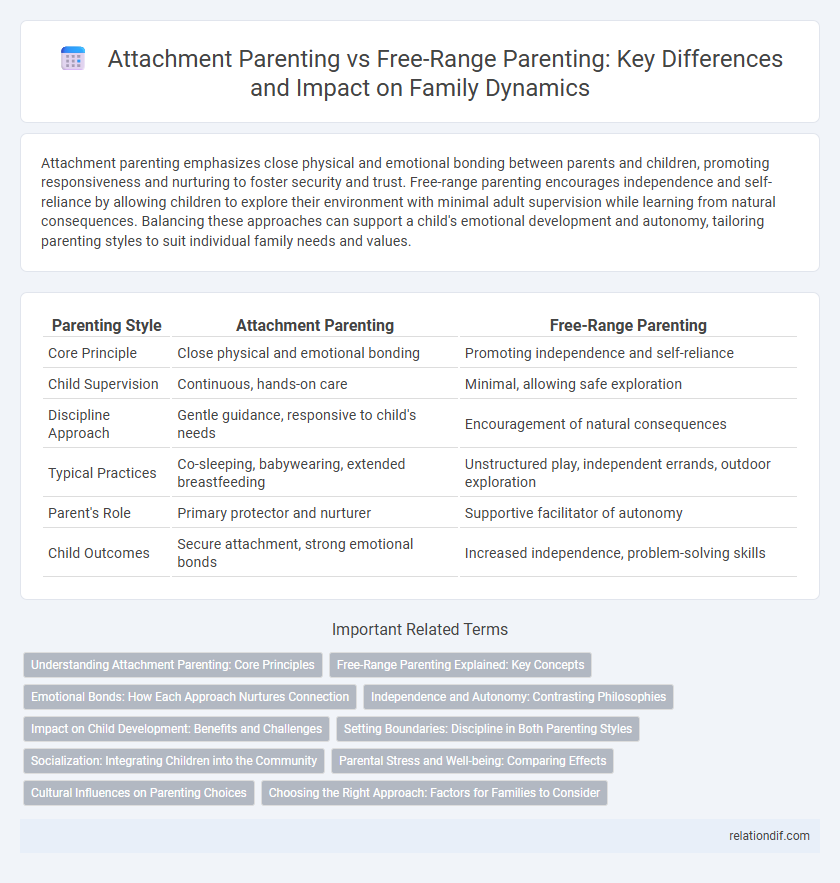Attachment parenting emphasizes close physical and emotional bonding between parents and children, promoting responsiveness and nurturing to foster security and trust. Free-range parenting encourages independence and self-reliance by allowing children to explore their environment with minimal adult supervision while learning from natural consequences. Balancing these approaches can support a child's emotional development and autonomy, tailoring parenting styles to suit individual family needs and values.
Table of Comparison
| Parenting Style | Attachment Parenting | Free-Range Parenting |
|---|---|---|
| Core Principle | Close physical and emotional bonding | Promoting independence and self-reliance |
| Child Supervision | Continuous, hands-on care | Minimal, allowing safe exploration |
| Discipline Approach | Gentle guidance, responsive to child's needs | Encouragement of natural consequences |
| Typical Practices | Co-sleeping, babywearing, extended breastfeeding | Unstructured play, independent errands, outdoor exploration |
| Parent's Role | Primary protector and nurturer | Supportive facilitator of autonomy |
| Child Outcomes | Secure attachment, strong emotional bonds | Increased independence, problem-solving skills |
Understanding Attachment Parenting: Core Principles
Attachment parenting emphasizes nurturing a secure emotional connection by responding sensitively to a child's needs, fostering trust and stability. Core principles include practices like constant physical closeness, breastfeeding on demand, and consistent, compassionate caregiving that supports the child's emotional development. This approach aims to build a strong foundation for healthy relationships and self-regulation throughout life.
Free-Range Parenting Explained: Key Concepts
Free-range parenting emphasizes fostering independence and self-reliance in children by allowing them to explore, make decisions, and face natural consequences with minimal adult supervision. Key concepts include promoting age-appropriate freedom, encouraging problem-solving skills, and building confidence through experiential learning in real-world settings. This parenting style contrasts with attachment parenting by prioritizing autonomy, trust, and resilience over constant physical closeness and caregiving responsiveness.
Emotional Bonds: How Each Approach Nurtures Connection
Attachment parenting fosters emotional bonds through consistent responsiveness, physical closeness, and nurturing practices that build child security and trust. Free-range parenting nurtures connection by encouraging independence and self-reliance, allowing children to develop confidence while maintaining open communication with caregivers. Both approaches emphasize emotional security but differ in balancing protection with autonomy to strengthen parent-child relationships.
Independence and Autonomy: Contrasting Philosophies
Attachment parenting emphasizes close physical and emotional bonding to foster security, which can support a child's sense of trust but may sometimes limit early independent exploration. Free-range parenting prioritizes granting children more freedom and responsibility, encouraging self-reliance and autonomy through experiential learning. These contrasting approaches reflect differing beliefs about the balance between protection and independence in child development.
Impact on Child Development: Benefits and Challenges
Attachment parenting fosters secure emotional bonds, promoting empathy, self-confidence, and social competence in children, while potentially leading to dependency if boundaries are unclear. Free-range parenting encourages independence, problem-solving skills, and resilience by allowing children to explore and take risks, though it may increase exposure to safety hazards without adequate supervision. Balancing nurturing guidance with autonomy is crucial to optimizing child development outcomes and addressing the unique needs of each family.
Setting Boundaries: Discipline in Both Parenting Styles
Setting boundaries in attachment parenting involves gentle discipline techniques such as positive reinforcement and consistent routines that foster security and trust between parent and child. Free-range parenting emphasizes granting children autonomy while implementing clear, age-appropriate limits to encourage independence and decision-making skills. Both styles prioritize consistent, respectful communication to establish discipline that balances guidance with freedom.
Socialization: Integrating Children into the Community
Attachment parenting fosters strong emotional bonds through close physical contact and responsive caregiving, which supports secure social development and empathy in children. Free-range parenting emphasizes independence and self-reliance, encouraging children to engage with diverse social settings and build problem-solving skills. Both approaches aim to integrate children into the community but differ in the balance between guided interaction and autonomous exploration.
Parental Stress and Well-being: Comparing Effects
Attachment parenting, emphasizing close physical contact and responsiveness, often reduces parental stress by fostering emotional bonding and providing reassurance about child safety. In contrast, free-range parenting encourages independence, which can increase initial stress levels as parents relinquish control but may enhance overall well-being by promoting child autonomy and parental confidence. Studies indicate that balancing protective involvement with freedom helps optimize parental mental health and resilience.
Cultural Influences on Parenting Choices
Cultural influences significantly shape parenting choices, with attachment parenting often emphasized in collectivist societies that value close family bonds and interdependence. In contrast, free-range parenting thrives in individualistic cultures prioritizing independence and self-reliance from an early age. Understanding these cultural frameworks helps explain the diverse approaches parents adopt worldwide to nurture and guide their children effectively.
Choosing the Right Approach: Factors for Families to Consider
Families choosing between attachment parenting and free-range parenting should evaluate their children's temperament, safety needs, and the family's values regarding independence and emotional closeness. Attachment parenting emphasizes nurturing strong bonds through practices like co-sleeping and responsive caregiving, supporting emotional security. Free-range parenting encourages autonomy by allowing children to explore and take risks within safe boundaries, fostering self-confidence and problem-solving skills.
attachment parenting vs free-range parenting Infographic

 relationdif.com
relationdif.com